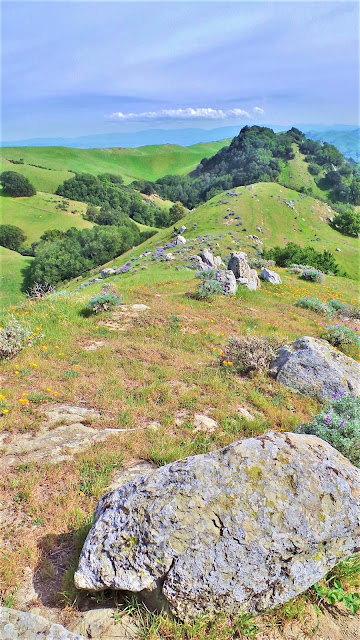LAS TRAMPAS REGIONAL WILDERNESS: Chamise Trail to Las Trampas Ridge, Elderberry Trail to Rocky Ridge & the Devil’s Hole (Sycamore Trail Loop)

In the mood for a day of hiking tough terrain with lots of elevation gain, but don’t want to drive more than 40 minutes?

Prepare yourself for the reward of grueling ascents up tepui-like ridges, topping out on oak-studded roller coast summits offering amazing views of remote East Bay watershed lands.

Looking for a chance to spot diverse flora and fauna, investigate intriguing, hard to get to placesakes packed with history and mystery?

You’re there in under an hour. The first all-around choices in the East Bay for such an enticing destination are Mount Diablo State Park, Sunol-Ohlone Regional Wilderness, and the “third sister” of the Diablo/Ohlone Range, Las Trampas Regional Wilderness.

It’s a landscape that encompasses thousands upon thousands of acres (27,000 of them) of the East Bay Water District’s (EBMUD) watershed territory between the Berkeley / Oakland Hills and far Eastern Contra Costa County.

It lies beyond the purlieus of the more heavily populated regions, but as the crow flies, the regional wilderness is ridiculously close to the metropolitan scramble and sprawl.

Las Trampas Regional Wilderness (Spanish for the “Snares”, homage to its heritage as a land ‘o plenty when traps were once set in the chaparral of the hills to catch elk and antelope) is of great geological interest to rockhounds, history buffs, and nature freaks.

Essentially, it comprises an ecological island of diverse plant and animal communities, a singularly rugged and unspoiled place, a surprisingly remote place in the truest sense of that word.

Even though its nearly 3800 acres are directly east “just” across the Berkeley Hills, you have to drive to get there from Berkeley, forced by rugged East Bay hinterlands to veer south on I-580, then northeast on Crow Canyon Road.

Then turning west on Bollinger Canyon Road to access the trail heads west of the I-680 corridor leading south to San Jose. (One could, if one had sufficient luxury, devote an entire day to hiking there and back over several ridge systems from Berkeley – hey! Why not?)

Oddly, Las Trampas has always been one of those places (in my mind only) “too far away” and “not exotic enough” to have courted it much. This sad misconception has prevented many a fine romp in this Diabloan wilderness.

Given half a chance, Las Trampas provides a wonderful escape from urban pressures, right there for the taking (providing you have a car or a loooong day to bike or hike there).
.jpg)
But prepare yourself for solitude – you won't encounter too many folks.
Where else can you enjoy lung-busting climbs to rocky ridges offering breathtaking 360-degree views of Ramage Peak at 1401 feet, Mount Diablo at 3849 feet, the Ohlone Ridge out beyond Livermore, and Grizzly Peak and Volvon Peak dominating the Berkeley Hills horizon? Pick and sniff some super-sweet lemony black sage, rejoice in the chaparral, chamise, and grasslands?
.jpg)
Give praise to the oak-bay-madrone-manzanita communities, and love those eagles, hawks, and buzzing buzzards (turkey vultures, cousin to the more glamorous California Condor) patrolling the deep blue skies?
.jpg)
Shake off the frisson of adrenaline rush, knowing that bobcats and mountain lions are skulking about or sleeping nearby in the sandstone cave outcroppings? Give thanks for lovely seasonal creeks cutting the divides between the ridges creating the life-sustaining riparian zones so vital to many species’ – fox, bobcat, mountain lion, deer, coyote, skunk, weasel, fish, newt, birds, insects – existence, indeed, survival?

Where else? Certainly, plenty of places – the first and second “sisters” doubtlessly – otherwise I defy you to find such a place under 40 minutes from two million people.
A major attraction (for me) of Las Trampas is the lore associated with the place – of black panther (yes, black panther) sightings in the Devil’s Hole area for starters.
.jpg)
San Francisco Chronicle Outdoor writer Tom Stienstra has wildlife scientist and mountain lion expert for the East Bay Regional Park District, Steve Bobzian, on record saying, "We're getting at least one or two black panther sightings a year."

Wow! Better hope you’re quick to the draw to get that on film! Then, there are swashbuckling tales of hidden loot stashed by the Robin Hood like bandit, Joaquin Murrieta, secreted high in remote sandstone caves.

This makes for sheer good fun just scrambling in and among the pockmarked outcrops poking around looking for a clue of treasure; or hoping for a million-dollar glimpse – at a respectable distance – of the mysterious big black cat.

Bollinger Creek dissects the park. The west valley is walled by Rocky Ridge at 2,024 feet. The east valley, Las Trampas Ridge, tops out at over 1900 feet. Two major faults – the Las Trampas and Bollinger Faults – account for the uplift and exposure, holding remnants of ancient shoreline and fossiliferous bedrock.

Fertile soil provides habitat for coast live oak and bay laurel trees, as well as buckeyes, big leaf maples, canyon live oak, black oak, and scrub oak. Ferns abound. Grasslands and meadows unfold. Field mice proliferate.

Accipiters and raptors do their swooping thing all day long.
Seasonally, Las Trampas undergoes personality transformations (as does the entire Bay Area).

Summers and early Fall bring tinder-box dry conditions, golden hills, inferno heat. Winter brings the life-bearing rains (maybe lucky to get five to ten inches a year), and then Springtime, the loveliest of seasons, arrives with Hibernian hillsides strewn with profuse wildflowers and sweet songs of running brooks.

And always, the eternal longing sense of rebirth or rediscovery in the magical epiphanies of nature animism.

Check out another Gambolin' Man post on the amazin' wonders of Las Trampas:

A couple of live-action snippets of this wonderful place:
.jpg)

0 Comments:
Post a Comment
<< Home